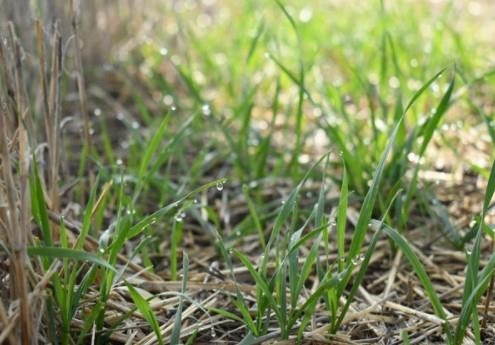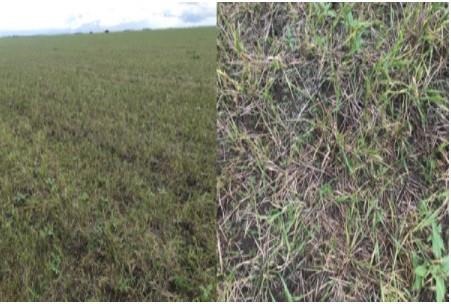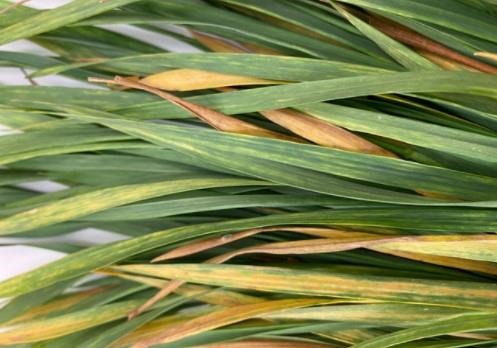By Kelsey Andersen and Romulo Lollato et.al
This past season was a bad one for wheat streak mosaic virus (and other viruses vectored by the wheat curl mite) in parts of Kansas. Late summer rainfall in 2020 was favorable for volunteer wheat establishment in some areas. One of the best preventative measures for wheat streak is the control of volunteer wheat early and often after harvest. If volunteer wheat is allowed to stand, it creates a “green bridge”, allowing wheat streak mosaic and wheat curl mites to survive locally. Volunteer wheat should be terminated at least two weeks prior to planting to allow sufficient time for mites to die off.
Challenges faced in 2020-21
This year, the wheat crop faced several challenges that might have increased the amount of seed left behind after harvest, which could also increase the amount of volunteer wheat (Figure 1). These problems included:
- Excessive rainfall delayed wheat harvest in many parts of the state
- Freeze damage during late boot and early heading (which caused many delayed wheat heads to emerge), particularly in parts of south-central and southwest Kansas
- Hailed-out wheat
- A considerable amount of head scab (Fusarium head blight) even in western Kansas, where this disease is usually not a problem
- Waterlogged conditions in parts of central Kansas
- Drought-stressed wheat in southwest Kansas

Figure 1. Volunteer wheat that has emerged in wheat residue.
Breaking the “green bridge”
Wheat curl mites will move off growing wheat as the green tissue dries down and dies. After moving off the existing wheat at or near harvest time, the mites need to find green tissue of a suitable host soon or they will die (death of the whole population will take approximately 2 weeks).
Producers often like to wait several weeks after harvest before making their first herbicide application to control volunteer wheat. This allows as much volunteer as possible to emerge before spraying it or tilling it the first time. Glyphosate and atrazine are two herbicides that are often used for this purpose. Additional information about controlling volunteer wheat can be found in a recent eUpdate article: “Considerations for weed control following wheat harvest”. Often, a second application or tillage operation will be needed later in the summer to eliminate the green bridge to fall-planted wheat by making sure all volunteer is dead within ½ mile of wheat being planted in the fall. As we saw in 2020, wet weather through late summer often favors multiple flushes of volunteer wheat (Figure 2) and also favors the growth of other grassy weeds that can also support moderate populations of the curl mites and virus.

Figure 2. Thick stand of volunteer wheat after wheat harvest (left panel) and detail of volunteer wheat crop development (right panel).
Other hosts for the wheat curl mite
Volunteer wheat is not the only host of the wheat curl mite. Over the years, multiple research studies have evaluated the suitability of wild grasses as hosts for both the curl mite and the wheat streak virus. There is considerable range in the ability of a grassy weed species to host the mite and the virus. Barnyardgrass is among the more suitable hosts for both virus and mites, but fortunately it is not that common in wheat fields. In contrast, various foxtails, although a rather poor host, could be an important disease reservoir simply because of their abundance. These grasses may play an important role in allowing the mites and virus to survive during the summer months particularly in the absence of volunteer wheat.
The K-State Research and Extension publication, MF3383 - Wheat Streak Mosaic, includes information about grassy weed hosts of the mite and virus, and the contribution of these hosts to the risk of severe wheat streak mosaic infections. Take note of significant stands of these grasses in marginal areas and control them as you would volunteer wheat.
If volunteer wheat and other hosts are not controlled throughout the summer and are infested with wheat curl mites, the mites will survive until fall and could infest newly planted wheat. Wheat curl mite infestations of wheat often lead to wheat streak mosaic infections (Figures 2 and 3).

Figure 3. Close-up of wheat showing symptoms of a wheat streak mosaic virus infection in the fall.
Management with genetic resistance: One tool in the toolbox
Other than timely control of volunteer, genetic resistance is also an important tool for WSMV control. Genetic resistance to wheat streak mosaic can also reduce the risk of severe disease problems. There are currently a few varieties adapted to Kansas that have wheat streak mosaic resistance, including KS Dallas (red), KS Hamilton (red), Guardian (red), Oakley CL (red), Joe (white), and Clara CL (white). All of these varieties have the same resistance source (a wheat resistance gene named WSM2). The OSU variety Breakthrough has the WSM1 resistance gene. These resistance genes help, but have some serious limitations. For example, they are effective against wheat streak mosaic virus but does not cover triticum mosaic or high plains viruses (two other viral diseases also spread by the wheat curl mites). The resistance conferred by WSM2 is also temperature sensitive and is much less effective at high temperatures, although the resistance in KS Dallas seem to endure greater temperatures before breaking down. If wheat is planted early for grazing or if high temperatures persist into October, the resistance is much less effective. KS Silverado (white) also has temperature sensitive resistance to wheat streak mosaic, although from a different source other than WSM2.
In addition, there are a handful of varieties with resistance to the wheat curl mite, including TAM 112, Byrd, Avery, Langin, KS Western Star, Whistler, Canvas, Guardian, Crescent AX, Incline AX, Fortify SF, TAM 115, TAM 204, and T158. These varieties are actually susceptible to the viral diseases, but they generally slow the development of the mite populations in the fall. This resistance can help reduce the risk of severe disease but will not provide enough protection if wheat is planted in close proximity to volunteer wheat or other hosts infested with large populations of the curl mites and virus.
Source : ksu.edu